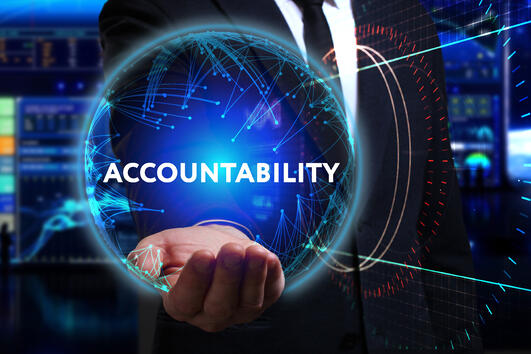Virtual Accountability

What is an Accountability Culture?
In our recent whitepaper on virtual accountability, we defined personal accountability as “delivering on a commitment and accepting responsibility for the outcome.” Personal accountability is an internal force that drives behavior. Your agents and advisors can choose to hold themselves accountable. At best, you can impose consequences; you can’t compel them to feel personally accountable.
However, what you can do as a leader is create a culture that supports and nurtures accountability by applying what we call the three E’s: Expectations, Environment, and Encouragement.
In their book, How Did That Happen? Holding People Accountable for Results the Positive, Principled Way, the authors define an accountability culture as:
“a place where people think and act, on a daily basis, in the manner necessary to develop successful solutions, find answers, overcome obstacles, triumph over any trouble that might come along, and deliver results. People in a culture of accountability follow through to make sure they do what they say they will do, commit themselves to get to the truth, no matter what, and feel free to say what needs to be said.”1
Clarifying expectations, creating an environment that recognizes and reinforces accountability, and providing encouragement and support are the steps to building the kind of culture the authors describe.
In this post, we take a more in-depth look at clarifying and communicating expectations for a remote workforce.
Building Trust through Expectations
At its core, accountability is about trust. You trust that your agents, advisors, and staff will perform the required activities to achieve results. Your agents, advisors, and staff trust that you will provide the leadership, resources, and guidance they need to succeed.
In his best-selling book, The Speed of Trust, author Stephen M.R. Covey identifies clarifying expectations as one of the critical behaviors for building trust. To build trust through expectations, Covey says:
“Create a shared vision and agreement about what is to be done upfront. If you don’t do this upfront, you will have trust issues later. Check for clarity. Disclose and reveal expectations. Discuss them. Validate them. Renegotiate them if needed and possible. Don’t violate expectations. Don’t assume that expectations are clear or shared.”2
Remote-Work Expectations
For leaders in financial services, the kind of rigor Covey describes in setting and communicating expectations is common when discussing productivity and performance. Have you also established expectations regarding remote work?
Remote-work expectations to consider include:
Availability. Do you expect members of your team to be available during core work hours? People are juggling additional responsibilities during the pandemic. They may be managing homeschooling for their children as well as managing their practices. If you have expectations about their availability while working from home, be sure to communicate these and work with our team members to address challenges.
Response Time. Are there standards regarding responding to messages from clients and other team members? Even if you decide not to establish specific criteria for response times, it’s a good idea to give guidelines to your team. Agreeing, for example, that team members include in voicemail or email messages when a request is urgent or has a deadline.
Meetings. Is attendance at meetings required? Participation in meetings that were optional when everyone was working in the office might now be necessary. If your expectations have changed, be sure to communicate this to all team members. The same applies to your expectations about participation in meetings. Do you expect each team member to report out? Are there specific agenda items to be addressed?
Communications. How frequently will you plan to check in on your team? When do you expect them to check in with you? Frequent and consistent communication is especially important for newer agents and advisors who may feel uncomfortable asking for help. Leaders in our onboarding study have significantly increased their contacts with new agents and advisors to keep them on track and to bolster their sense of belonging.
Technology. What level of expertise does your team have in using videoconferencing, collaboration, or messaging technology, and what are your expectations regarding learning these tools? Do you expect team members to have a contingency plan in place should they run into technical issues? Even a request as simple as, “I expect everyone to turn on their video during our all-team virtual meeting” helps to establish clear expectations regarding remote work.
Work-From-Home Policies. These policies typically cover items such as sick time and vacation time while working from home and can be especially useful in clarifying expectations for staff. Other topics often covered are expectations regarding the work environment and information security. Your company’s human resources team can help you establish a policy if you don’t already have one.
Accountability Starts in the Recruiting Process
Screening candidates for strong remote-work skills such as self-motivation (see our Virtual Recruiting and Selection white paper) is the first step in creating an accountability culture. Remote work is not for everyone. The candidates you select should be just as motivated working from home as they would be in the office.
Notice that Covey says to “create an agreement about what is to be done upfront.” Be sure to discuss remote work expectations with candidates during the recruiting and selection process just as you do activity and productivity expectations.
Practice Accountability
Practicing accountability is another of the behaviors that Covey identifies for building trust. He writes:
“There are two key dimensions to this Practice Accountability. The first is to hold yourself accountable; the second is to hold others accountable. Leaders who generate trust do both… When people—particularly leaders—hold themselves accountable, it encourages others to do the same… It also creates an environment of openness and trust.”
Trust is a two-way street. Your team is trusting you to hold yourself accountable for providing the encouragement, resources, and support they need to succeed and for creating an environment that encourages and appreciates personal accountability.
How are Field Leaders Adapting Their Processes for Virtual Accountability?
To learn more about the virtual accountability strategies that agency and firm leaders are using with their remote work teams, download our Virtual Accountability research whitepaper.
1 Connors, R., & Smith, T. (2011). How Did That Happen?: Holding People Accountable for Results the Positive, Principled Way (Reprint ed.). Portfolio Trade.
2 Covey, S. M., Covey, S. R., & Merrill, R. R. (2008). The SPEED of Trust: The One Thing That Changes Everything (Reprint ed.). Franklin Covey.


